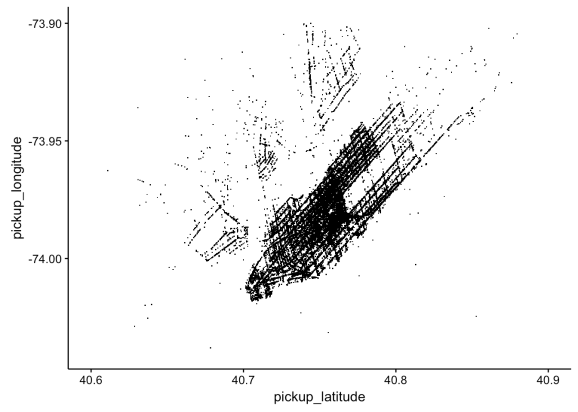R code to accompany Real-World Machine Learning (Chapter 6): Exploring NYC Taxi Data
Want to share your content on R-bloggers? click here if you have a blog, or here if you don't.
Abstract
The rwml-R Github repo is updated with R code for exploratory data analysis of New York City taxi data from Chapter 6 of the book “Real-World Machine Learning” by Henrik Brink, Joseph W. Richards, and Mark Fetherolf. Examples given include reading large data files with the fread function from data.table, joining data frames by multiple variables with inner_join, and plotting categorical and numerical data with ggplot2.
Data for NYC taxi example
The data files for the examples in Chapter 6 of the book are available at
http://www.andresmh.com/nyctaxitrips/.
They are compressed as a 7-Zip file archive
(e.g. with p7zip), so you will
need to have the 7z command available in your path to decompress and load
the data.
(On a mac, you can use Homebrew to install p7zip with
the command brew install p7zip.)
Using fread (and dplyr…again)
As in Chapter 5, the fread function from the
data.table library is used to quickly read in a sample of the rather large
data files. It is similar to read.table but faster and more convenient.
The following code reads in the first 50k lines of data from one of the
trip data files and one of the fare data files. The mutate and filter
functions from dplyr are used to clean up the data (e.g. remove data
with unrealistic latitude and longitude values). The trip and fare data are
combined with the inner_join function from the dplyr package.
tripFile1 <- "../data/trip_data_1.csv"
fareFile1 <- "../data/trip_fare_1.csv"
npoints <- 50000
tripData <- fread(tripFile1, nrows=npoints, stringsAsFactors = TRUE) %>%
mutate(store_and_fwd_flag =
replace(store_and_fwd_flag, which(store_and_fwd_flag == ""), "N")) %>%
filter(trip_distance > 0 & trip_time_in_secs > 0 & passenger_count > 0) %>%
filter(pickup_longitude < -70 & pickup_longitude > -80) %>%
filter(pickup_latitude > 0 & pickup_latitude < 41) %>%
filter(dropoff_longitude < 0 & dropoff_latitude > 0)
tripData$store_and_fwd_flag <- factor(tripData$store_and_fwd_flag)
fareData <- fread(fareFile1, nrows=npoints, stringsAsFactors = TRUE)
dataJoined <- inner_join(tripData, fareData)
remove(fareData, tripData)Exploring the data
In the complete code-through, plots of categorical and numerical
features of the data are made using
ggplot2, including a visualization of the pickup locations in latitude and
longitude space which is shown below. With slightly less than 50,000 data
points, we can clearly see the street layout of downtown Manhatten.
Many of the trips originate in the other boroughs of New York, too.

Feedback welcome
If you have any feedback on the rwml-R project, please
leave a comment below or use the Tweet button.
As with any of my projects, feel free to fork the rwml-R repo
and submit a pull request if you wish to contribute.
For convenience, I’ve created a project page for rwml-R with
the generated HTML files from knitr, including a page with
all of the event-modeling examples from chapter 6.
R-bloggers.com offers daily e-mail updates about R news and tutorials about learning R and many other topics. Click here if you're looking to post or find an R/data-science job.
Want to share your content on R-bloggers? click here if you have a blog, or here if you don't.
